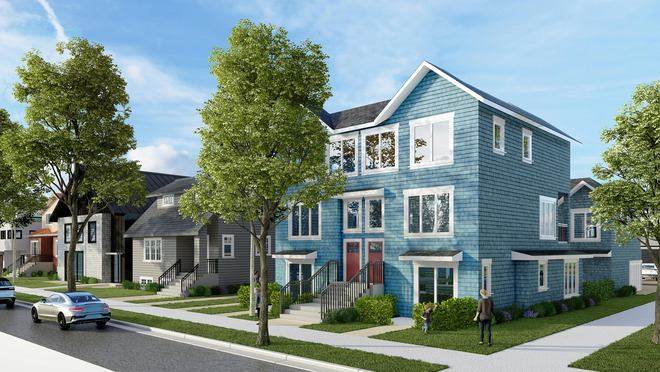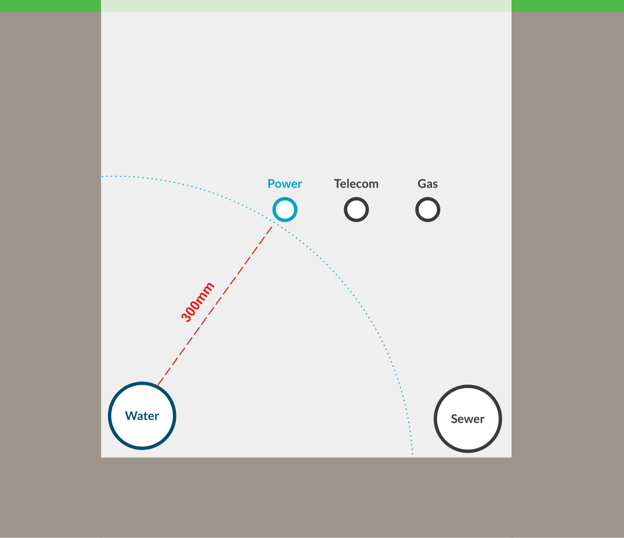Small-scale, multi-unit housing guide for local governments

What is small-scale, multi-unit housing?
Multiplexes, also known as small-scale, multi-unit housing (SSMUH), are dwellings with up to four to six units, depending on the lot size and location. As of June 30, 2024, most local government bylaws in B.C. now accommodate this housing type.
Planning together helps us provide electricity efficiently
We've compiled recommendations below for our local government partners that will help us connect this new housing to the electrical grid quickly, cost effectively and safely.
Learn what you can do when talking to builders and in your legislations to support small-scale, multi-unit housing in your community.
What local governments should communicate to builders
Your permits desk team can help streamline new small-scale, multi-unit housing connections by ensuring that your community's builders and developers are aware of a number of important requirements and opportunities.
1. Confirm they've contacted us
When a prospective applicant first contacts you – whether they're asking about requirements or bringing in a completed package – confirm that they've already reached out to us. That initiates our team to work on the electrical designs the applicant will need.
2. Make sure plans allow space for our infrastructure
Confirm an applicant's site plan includes a dedicated minimum 3.6 by 3.6-metre space for a low-profile transformer, should we need to install one. If we later conclude that overhead service would be possible, the builder or developer can reallocate the space for a parking spot, bicycle rack, or vegetation.

Site plan with 3.6 by 3.6 metre space for low profile transformer.
3. Verify that required safety clearances are clearly marked
Project drawings must clearly indicate the required safety setbacks and clearances from our infrastructure – including overhead wires and transformers. For specifics, please see the diagrams below, or reference our new guide to utility clearance requirements [PDF, 303 KB].
Include a 6 metre setback from building structures to the nearest pole mounted transformer.
4. Encourage them to design for energy efficiency
Encourage builders to prioritize energy efficiency and demand reduction from the get-go. For example, a builder or developer could:
- Install an electric vehicle (EV) energy management system. This can lower the overall power needs of the home and potentially reduce building costs.
- Make use of historical load calculations, including peak energy usage, when renovating an existing home to add additional units. Technical Safety BC allows historical calculations to inform panel upgrades. Log in to export data from MyHydro.
- Bring together the whole project team at the start to look for opportunities to optimize a planned home's overall performance while reducing build costs. The CSA Group's open-access HVAC guide for Part 9 homes (CSA SPE-17:23) is an excellent free resource to support these discussions.
Ways local governments can enable these residential connections
There are things you can do as a local government to help streamline the new connections.
While the majority of local governments approve our designs for electrical connections, there are some that have adopted beautification policies requiring builders to bury all new electrical connections underground. This results in costs up to 10 times higher than overhead connections, and can take 10 to 18 months to plan and connect. In existing neighbourhoods where overhead service is available, we'd like the flexibility to tie into the existing infrastructure when it's the most efficient and cost-effective solution for the site.
Example
For many years the City of Vancouver had an underground-service requirement rule. When its staff approached us looking for opportunities to streamline permits for new multiplexes and laneway homes, we explained that the rule was costing builders time and money. After further internal discussions, they decided to remove the restriction.
Similarly, if your government requires underground service connections in new small-scale, multi-unit housing, we'd welcome a discussion on the advantages of the traditional overhead connection approach.
That said, underground service remains an option, and may actually be necessary at a given site – should technical barriers prevent use or expansion of overhead infrastructure. To minimize costs and delays, we're asking local governments to allow us to make the call on the best solution, without restrictions.
Small-scale, multi-unit housing is by definition built in compact spaces. When a developer adds as many as six homes to a lot originally intended for one—and in situations where we need to route power underground—multiple utilities often need to share the same servicing trench.
Some municipalities have set their own requirements for minimum separation between underground municipal utilities and electrical conduit and may require as much as 1.5 metres of spacing.
Local governments can simplify design time and service connections by accepting the Canadian Standards Association (CSA) standard of 300 millimetres (mm) utility separation in new underground service connections. (For reference, the specific code citation is C22.3 No. 7, Clause 6.2.1.1).

Servicing trench cross section example. We're asking local governments to accept the CSA standard of 300 mm for utilities separation.
Beyond utility separation clearances, there are other challenges associated with delivering underground electrical service to small-scale, multi-unit housing. Underground electrical service requires a low-profile transformer near the project site.
While we ask builders to allocate space for this infrastructure in their site plans, in some cases it's not possible due to parking requirements, protected trees, or a pre-existing easement.
In cases where we and the builder have exhausted all possible locations inside lot lines, we're asking local governments to allow us the flexibility to accommodate a low-profile transformer on public property. An adjacent boulevard might be suitable, for example.
In such a circumstance, the builder would request that you accommodate the infrastructure, and we'd confirm that we've visited the site and ruled out all other options. Note: Some local governments already allow this.

Low profile transformer on city boulevard.
Connect with us
If you have questions about this information or would like to discuss ideas, please email us at localgov@bchydro.com.
To begin a connection request, builders and developers can submit connection requests online through MyHydro. Learn about connection requests
Resources
